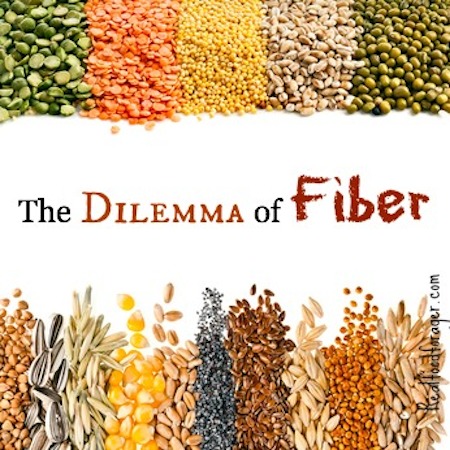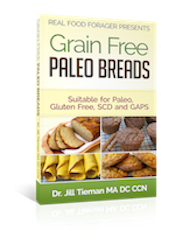
The food industry has jumped on the fiber-is-good-for-your-health bandwagon. As a result, they are insidiously developing artificial fiber-like products to add to packaged foods. These foods are marketed as fiber rich with the government’s stamp of approval for health claims. However, some of these fiber products are as dangerous as synthetic food can get.
Fiber for Health?
Much ado has been made for adding fiber to your diet to improve health in regards to diabetes, heart disease , cholesterol lowering (questionable value), cancer (also some find it protective, some not) and metabolic syndrome. While there are studies supporting these health claims, there are also studies that indicate that too much fiber can exacerbate certain conditions, such as, diverticulosis, constipation and mineral absorption in general (due to the phytic acid in many fibers).
Additionally, the anecdotal case reports of people on healing diets like the Specific Carbohydrate Diet and the GAPS diet and other low carbohydrate diets, support those in the too much fiber is not good category. These diets all restrict dietary fiber from starches, sugars and grains.
This concept asserts that a damaged gut will not digest starches properly and they will remain in the gut for the pathogenic bacteria to feed upon. The majority of the fiber allowed on these diets is obtained from vegetables, small amounts of fruits and nuts as tolerated.
These diets definitely work to reduce symptoms for a large percentage of the people who can manage them with 100% dedication. This means that there are no starches, no grains and no disaccharides in the diet. This includes all naturally occurring fibers such as wheat bran, oat bran and psyllium that have been typically added to foods to increase the fiber content.
The goal of these grain free healing diets is to starve out the pathogenic bacteria and add in beneficial bacteria with probiotic foods such as sauerkraut, yogurt and eventually kefir (and supplementation of probiotics).
The question is, when is it appropriate to resume eating some of the starchy foods that can feed the healthier microbiome?
Types of Fiber
Due to the new manufactured fibers, we need to discuss not only the two types of fiber, soluble and insoluble, but also, we now have isolated fibers and/or functional fibers. Let’s clarify the issues and then discuss the compelling reason to never eat foods with these added synthetic fibers.
The Institute of Medicine (IOM) categorizes fiber (in their Dietary Reference Intakes) as either dietary fiber or functional fiber. Dietary fiber is classified as non-digestible carbohydrates and lignins that are intrinsic and intact in plants.
Within this category, dietary fiber may be soluble or insoluble.
Soluble Fiber
Soluble fiber refers to naturally occurring fibers from oatmeal, oat cereal, lentils, apples, oranges, pears, oat bran, strawberries, nuts, flaxseeds, beans, dried peas, blueberries, psyllium, cucumbers, celery, and carrots.
This type of fiber is soluble in water and forms a gel in the intestines which slows down digestion. For some, this is a good thing as it delays the emptying of your stomach and makes you feel full, which helps control weight. It may also help with insulin sensitivity and thus help diabetics.
Insoluble Fiber
Insoluble fibers do not dissolve in water, but pass through the digestive tract. This serves to bulk up the stools and help some with constipation. It also increases the motility of the digestive tract.
Food sources of insoluble fiber are whole wheat, whole grains, wheat bran, corn bran, seeds, nuts, barley, couscous, brown rice, bulgar, zucchini, celery, broccoli, cabbage, onions, tomatoes, carrots, cucumbers, green beans, dark leafy vegetables, raisins, grapes, fruit, and root vegetable skins. (source)
Added fiber is recognized by officials to benefit human health in three ways:
- Fiber helps to keep blood glucose steady by binding with fatty acids and slowing digestion so blood sugars are released more slowly into the body.
- Fiber helps to reduce risk of coronary artery disease by lowering bad cholesterol
- Fiber improves regular bowel movements by hydrating, controlling pH levels and moving waste through the intestines.
These are allowable health claims that have been used by the food industry for marketing purposes. For instance, oat meal and other cereal grains are marketed as being able to reduce blood cholesterol levels, thus protect from heart disease.
The suggested daily fiber intake is 25 to 38 g for adolescents and adults. It is estimated that most people fall short of that with less than 15 grams a day.
Food Industry Jumps on Low Fiber Intake
The food industry has jumped on this low fiber intake with the solution of adding fiber to processed foods. This type of fiber is called Isolated fibers and/or functional fibers.
Some of these functional fibers include, soluble corn fiber, polydextrose, and soluble fiber dextrin. These are added to packaged foods such as cereals, soups, baked goods, and meal replacements. (Source)
I would stay far away from this type of fiber which is manufactured from genetically modified corn.
Fiber – Good or Bad?
Against Fiber
There have been some opinions against fiber. Some people with gut imbalances (dysbiosis) have relief from their symptoms when going on starch, grain and sugar restrictive diets like the Specific Carbohydrate Diet (SCD), the GAPS diet and the Autoimmune Paleo Diet (as mentioned above), as well as low carb/sugar diets for candida and autism recovery. Although these diets do not have to be low fiber, as they include plenty of vegetables, they usually are low fiber.
Additionally, writers like Konstantin Monastyrsky in his book Fiber Menace, advise against added fiber to the diet. In fact, his book is devoted to presenting studies that show that fiber does NOT prevent colon cancer, breast cancer, heart disease or diabetes as we have been lead to believe by health officials.
In his book, there is a quote from The Functional Gastrointestinal Disorders textbook:
There is little or no relationship between dietary fiber and whole gut transit time. In fact, fiber delays transit time more than does any other food ingredient, and is the primary cause of chronic constipation, hemorrhoids, diverticulosis, ulcerative colitis, and Crohn’s disease. (p. 21,23, 29, 103)
Who to believe?
In Favor of Fiber
Fiber is necessary to feed the healthy microbiome. At this point, I should mention the issue of resistant starch. As the name implies, it is a type of starch that is resistant to human digestion and remains in the gut as food for the microbes to digest and feed upon.
There is a lot to talk regarding resistant starch – enough for a book. You can get lots of information about resistant starch here. (Follow the links as well).
Anyone who wants to nurture their healthy microbiome needs to feed it with fiber ( and according to some, resistant starch).
Interestingly, in this study published in Science in 2013 scientists have revealed a mechanism by which harmful bacteria grow, crowd out beneficial bacteria and damage the gut, in conditions of Inflammatory Bowel Disease (IBD).
Wow! That is exactly the concept underlying low carbohydrate, SCD and GAPS diets!
The researchers postulate that in IBD, where there is inflammation already, bacteria like Enterobacteriaceae (including some E. coli strains) use nitrate to survive. The nitrate is present when there is inflammation in the intestine. Lead author Andreas Baumler, a professor of medical microbiology and immunology at UC Davis said,
Much like humans use oxygen, E. coli can use nitrate as a replacement for oxygen to respire, produce energy and grow… In IBD, nitrate produced by inflammation in the gut allows E. coli to take a deep ‘breath,’ and beat out our beneficial microbes in the competition for nutrients… Determining the reasons why bacteria like E. coli can edge out good bacteria in the gut is crucial for determining new ways to halt the IBD disease process.
Well, there you go. This is exactly the concept the SCD and GAPS diets are founded upon.
Good Bacteria Need Fiber
Perhaps the most important takeaway here is that the pathogenic bacteria survive by feeding on the byproducts of inflammation (becoming a vicious cycle), yet the good bacteria survive on fermentation of fiber.
This suggests that you should eat fiber (and possibly resistant starch) to feed the good bacteria. I would imagine that it is possible, after months or a year or two on the SCD/GAPS, or low carb diets, to transition to a more fiber rich diet in order to nourish the good bacteria.
Many foods on the SCD, GAPS and Paleo diets are great sources of both soluble and insoluble fiber, such as yams and sweet potatoes, green leafy vegetables, carrots and other root vegetables, fruits with an edible peel (like apples and pears), berries, seeds, and nuts.
Jeff Leach of the American Gut project has been living in Tanzania for over a year and studying the Hadza. The Hadza are one of the few thriving and surviving hunter/gatherer tribes left on this earth. They have a lot of fiber in their diet and an amazingly diverse microbiome.
Current studies show that diversity is the key to a healthy microbiome.
I’d so love to see more research on this topic. I think it would make it a bit more clear to folks who feel ready to come off the SCD, low carb, Paleo or GAPS diets and start to eat some appropriate starches in order to nurture the good bacteria.
What do you think about these issues with fiber, resistant starch and feeding the microbiome? Does fiber help you or hurt you? Have you tired to add more fiber into your diet? Let’s continue the conversation in the comments!
Shared at: Hearth & Soul Hop, Allergy Free Wednesday, Real Food Wednesday
The owner of this website is a participant in the Amazon Services LLC Associates Program, an affiliate advertising program designed to provide a means for sites to earn advertising fees by advertising and linking to Amazon properties including, but not limited to, amazon.com, endless.com, myhabit.com, smallparts.com, or amazonwireless.com. Disclaimer
Tropical Traditions Gold Label Virgin Coconut Oil

Tropical Traditions Gold Label Coconut Oil is a product I use every day.










{ 5 comments… read them below or add one }
I certainly struggle with how to get more fiber and resistant starch into my diet while remaining within a GAPS/paleo framework. As I understand it resistant starch is present in cooked and cooled potatoes and rice, and remains to some extent after rewarming as long as the food is not heated too harshly. I totally relate to Monastyrsky’s “ever bigger broom” analogy for particularly grain-based fiber – the point that grains slow peristalsis while bulking stool and encouraging inflammation seemed like a pretty round condemnation of them for constipation relief. Sudden changes in carb intake can lead to uncomfortable side effects for those who are unaware of ways to sub sources of the various fiber types and how they play with gut flora.
Hi Lauren,
Yes, certainly one has to go about this on tip toe — so to speak, by introducing very small amounts of starch at first to test tolerability. It can be hard to know when one is ready for such a change if one has been on a grain free, low carb diet for a while.
Having experimented with this myself and learning that high fiber and starch both seem to exacerbate my rheumatoid arthritis, I find this whole area fascinating. I’ve recently learned that bifidobacteria (the beneficial ones everyone says we need more of) are Th1 stimulants. RA is a Th1 dominant disease (whereas IBD is a Th2 dominant disease). This could explain why the foods that increase bifido in the gut seem to help people with IBD but hurts me. It balances out their system, while making my imbalance worse. The problem is that people who quote the IBD research seem to see it as across-the-board proof that bifido. is beneficial to everyone. Now, I might be the exception that proves the rule, and I realize that. But I look forward to this field of science growing and becoming more nuanced and individualized (rather than broad-spectrum) in its advice. Pun intended Great article, Jill. I appreciate your willingness to explore the questions that don’t yet have answers.
Great article, Jill. I appreciate your willingness to explore the questions that don’t yet have answers.
Jo Eileen,
Thanks so much for sharing. Interestingly, Elane Gottshall (Breaking the Vicious Cycle and founder of SCD) always insisted that bifido was a problem for those with IBD and she strongly recommended staying away from that particular strain. That was years ago, before any microbiome research was conducted.
As you say, I think it will turn out to be a very individual experience whether or not someone has a Th1 or a TH2 issue. The Th1/Th2 nomenclature is vague and somewhat conjecture.
More importantly, figuring out the BEST way to re-implant the beneficial microbes (for many conditions) is the exciting research I am looking forward to – and it is quickly becoming the flavor of the day, so to speak. Researchers are chomping at the bit to get this research done!
Wonderful blog! Do you have any recommendations for aspiring writers?
I’m hoping to start my own blog soon but I’m a little lost on everything.
Would you advise starting with a free platform like Wordpress or go for a paid option? There are so many options out there
that I’m totally overwhelmed .. Any recommendations? Appreciate it!
{ 3 trackbacks }